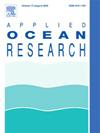Experimental investigation of the asymmetric oscillation mechanism of an oscillating water column wave energy converter
IF 4.3
2区 工程技术
Q1 ENGINEERING, OCEAN
引用次数: 0
Abstract
While numerous studies focus on the energy extraction rate of oscillating water column (OWC) converters, many assume symmetric water column oscillations within the flow field, despite observed discrepancies in real-world conditions. This study employs particle image velocimetry (PIV) to analyze flow field asymmetry under various regular wave conditions, with wave height being a key variable. Experimental results reveal significant differences in velocity distributions and flow patterns. At higher wave heights, a high-velocity region near the front wall of the OWC converter emerges as the primary outflow pathway, while the inflow largely adheres to the wave-induced flow velocity. These flow pattern variations closely correlate with the vortex evolution region. Further analysis uncovers asymmetry in vortex generation: the seaward vortex originates from a stable shear layer, whereas the leeward vortex forms through multiple flow separations and turbulent mixing. These vortices shape the asymmetric flow pattern, with the leeward vortex driving outflow near the front wall and the seaward vortex creating a high-velocity “curtain” that impedes water inflow. The inherent asymmetry in the flow field, minimal under weaker hydrodynamic conditions, becomes more pronounced at higher wave heights due to intensified vortex influences. Additionally, a symbiotic interaction between the seaward and leeward vortices is observed, where each influences the other's formation,This interplay ultimately impacts the overall flow dynamics and energy extraction efficiency.
振荡水柱波能转换器不对称振荡机理的实验研究
虽然许多研究都集中在振荡水柱(OWC)转换器的能量提取率上,但许多研究都假设流场中存在对称的水柱振荡,尽管在现实条件下观察到差异。本文以波高为关键变量,采用粒子图像测速法(PIV)分析了不同规则波条件下流场的不对称性。实验结果表明,在速度分布和流态上存在显著差异。在较高的波高下,OWC转化器前壁上出现一个高速区域,成为主要的流出通道,而流入则基本遵循波致流速。这些流型变化与涡演化区域密切相关。进一步分析揭示了涡旋形成的不对称性:向海涡旋起源于稳定的剪切层,而背风涡旋则是通过多次流动分离和湍流混合形成的。这些旋涡形成了不对称的流动模式,背风旋涡驱动前壁附近的流出,而向海旋涡形成了一个高速“帷幕”,阻碍了水的流入。流场固有的不对称性在较弱的水动力条件下是最小的,但在较高的波高时由于旋涡影响的加剧而变得更加明显。此外,在向海和背风涡旋之间观察到一种共生的相互作用,其中每个涡旋影响另一个涡旋的形成,这种相互作用最终影响整体流动动力学和能量提取效率。
本文章由计算机程序翻译,如有差异,请以英文原文为准。
求助全文
约1分钟内获得全文
求助全文
来源期刊

Applied Ocean Research
地学-工程:大洋
CiteScore
8.70
自引率
7.00%
发文量
316
审稿时长
59 days
期刊介绍:
The aim of Applied Ocean Research is to encourage the submission of papers that advance the state of knowledge in a range of topics relevant to ocean engineering.
 求助内容:
求助内容: 应助结果提醒方式:
应助结果提醒方式:


